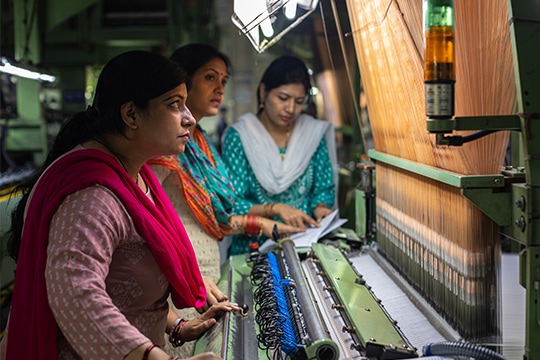The Economic Opportunity of India’s Women Workers – Goldman Sachs

Report on India’s Demographic Advantage and Female Labor Force Participation in the Context of Sustainable Development Goals

Introduction
India possesses a unique demographic advantage among major economies, characterized by a large proportion of its population entering working-age years. The country’s age-dependency ratio—the ratio of economically dependent individuals to the working-age population—is projected to be one of the lowest globally. This demographic trend presents a significant opportunity aligned with several Sustainable Development Goals (SDGs), particularly SDG 5 (Gender Equality), SDG 8 (Decent Work and Economic Growth), and SDG 10 (Reduced Inequalities).
India’s Demographic Transition and Economic Opportunity
India’s demographic transition is gradual and extended compared to other Asian countries due to slower declines in birth and death rates. Over the next two decades, India is expected to maintain a low dependency ratio, with fewer individuals under 15 or over 65 relative to the working-age population (15-65 years). This demographic window offers a powerful opportunity to accelerate economic growth and social development, supporting SDG 3 (Good Health and Well-being) and SDG 4 (Quality Education) through increased workforce participation and productivity.
Female Labor Force Participation in India
- Current Status: Female labor force participation rate (LFPR) in India stands at approximately 31%, significantly lower than the 54% observed in many developed and emerging economies, according to the International Labour Organization. Official Indian statistics report higher rates by including unpaid women workers engaged in household and non-farm activities.
- Challenges: The low participation of women in the workforce is a critical barrier to maximizing India’s demographic dividend and achieving gender equality (SDG 5).
Impact of Declining Fertility Rates and Female Workforce Inclusion
- As fertility rates decline, the growth rate of India’s labor force is expected to slow, potentially impacting economic growth.
- Increasing female labor force participation can offset this demographic shift by expanding the productive workforce.
- Raising female participation to previous peak levels could enhance India’s potential economic growth by approximately 1 percentage point, assuming other factors remain constant.
Policy Implications and Recommendations
- Promote gender-inclusive employment policies to support women’s entry and retention in the workforce, advancing SDG 5 and SDG 8.
- Invest in education and skill development programs tailored for women to improve employability and economic empowerment.
- Address social and structural barriers that limit women’s workforce participation, contributing to SDG 10 by reducing inequalities.
- Encourage data collection and research to monitor female labor force trends and inform policy decisions.
Conclusion
India’s favorable demographic window presents a strategic opportunity to drive sustainable economic growth by enhancing female labor force participation. Aligning efforts with the Sustainable Development Goals will not only promote gender equality and economic inclusion but also ensure long-term social and economic resilience.
1. Sustainable Development Goals (SDGs) Addressed or Connected
- SDG 5: Gender Equality
- The article focuses on increasing female labor force participation in India, directly relating to gender equality and women’s empowerment.
- SDG 8: Decent Work and Economic Growth
- Enhancing labor force participation, especially of women, is linked to economic growth and productive employment.
- SDG 3: Good Health and Well-being
- References to declining fertility rates and demographic transition imply connections to health and well-being.
- SDG 10: Reduced Inequalities
- Addressing disparities in labor force participation between genders contributes to reducing inequalities.
2. Specific Targets Under Those SDGs
- SDG 5: Gender Equality
- Target 5.5: Ensure women’s full and effective participation and equal opportunities for leadership at all levels of decision-making in political, economic, and public life.
- SDG 8: Decent Work and Economic Growth
- Target 8.5: Achieve full and productive employment and decent work for all women and men, including young people and persons with disabilities, and equal pay for work of equal value.
- SDG 3: Good Health and Well-being
- Target 3.7: Ensure universal access to sexual and reproductive health-care services, including family planning.
- SDG 10: Reduced Inequalities
- Target 10.2: Empower and promote the social, economic and political inclusion of all, irrespective of age, sex, disability, race, ethnicity, origin, religion or economic or other status.
3. Indicators Mentioned or Implied to Measure Progress
- Female Labor Force Participation Rate (LFPR)
- The article explicitly mentions the female labor force participation rate as a key measure, citing figures such as 31% participation in India compared to 54% in other major economies.
- Age-Dependency Ratio
- The share of economically dependent people compared to the working-age population is discussed as an indicator of demographic advantage.
- Potential Growth Rate
- Economic growth potential is linked to changes in labor force participation, with estimates of a 1 percentage point increase in growth by raising female participation.
- Fertility Rates
- Declining fertility rates are mentioned as part of demographic trends impacting labor force growth.
4. Table: SDGs, Targets and Indicators
| SDGs | Targets | Indicators |
|---|---|---|
| SDG 5: Gender Equality | Target 5.5: Ensure women’s full and effective participation and equal opportunities for leadership at all levels. | Female Labor Force Participation Rate (LFPR) |
| SDG 8: Decent Work and Economic Growth | Target 8.5: Achieve full and productive employment and decent work for all women and men. | Female Labor Force Participation Rate; Potential Growth Rate |
| SDG 3: Good Health and Well-being | Target 3.7: Ensure universal access to sexual and reproductive health-care services. | Fertility Rates |
| SDG 10: Reduced Inequalities | Target 10.2: Empower and promote social, economic and political inclusion of all. | Female Labor Force Participation Rate; Age-Dependency Ratio |
Source: goldmansachs.com








